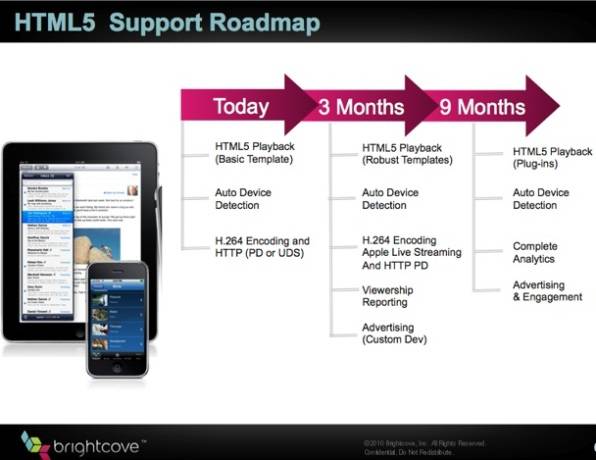Video platform provider Brightcove just announced the launch of a new tool for website publishers called the “Brightcove Experience Framework for HTML5.” The framework allows the company’s 1,300 customers create HTML5-compatible websites for delivering video content to Apple mobile devices, including the upcoming slate computer known as the iPad, as well as the iPhone and iPod Touch.

There has been a lot of debate about the move to HTML5 for Web video support, an area previously dominated by Adobe Flash and its accompanying Web browser plugin. Some publishers claim making the switch is a burden while others, most notably Apple CEO Steve Jobs, say the move is “trivial.” The truth, says Brightcove CEO Jeremy Allaire, is that “it depends.” For some publishers using homegrown video solutions, building a new HTML5 website is indeed hard work, but for customers using platform solutions (like his, of course), the transition is much easier.
Flash and HTML5 Will Coexist, Says Allaire
“Transition” might be the wrong word for describing the launch of HTML5-enabled websites like those said to be coming from NPR, the Wall St. Journal, and apparently, CBS. Companies aren’t just creating a new HTML5 website and discarding the older version – they’re creating a second website to complement the first. And both websites will run side-by-side for years, says Allaire. He, of anyone, should know. Now the CEO and founder of Brightcove, Allaire’s background includes a stint at Macromedia as the company’s CTO prior to its acquisition by Adobe. While there, he actually helped build the original Flash platform.

Brightcove Aims to Close Gap Between Flash, HTML5 Feature Sets
The device driving the adoption of the upcoming Web standard known as HTML5, the core markup language used to create the pages of the World Wide Web, is the Apple iPad. Like its smaller mobile siblings, the iPhone and iPod Touch, the iPad won’t support the Adobe Flash plugin.
Flash has long been a staple on the Web for things like video content, online ads and even casual games, but for various technological and political reasons, Apple does not support it on its mobile devices. According to Apple’s CEO Steve Jobs, this isn’t an issue, since creating websites using HTML5 technology is “trivial.” To some extent, that’s an accurate statement. Allaire confirms that at its most basic form, preparing a video and putting it on a webpage using HTML5 is not a difficult process.

The problem is that video publishers have come to expect more than just a simple video player like that what’s offered via HTML5 in its current state. They’re used to options like branded players, analytics, social media integrations, advanced player controls and other currently Flash-only options supported by Adobe’s technology. Brightcove, however, aims to catch up with Adobe’s feature set over the course of the year. At launch time, its HTML5 video player will support basic playback, auto device detection and H.264 encoding. In three months, more features will be added including “robust templates” to replace the basic ones available now, viewership reporting, advertising and more. And by the close of 2010, the company will offer publishers complete analytics, advertising and engagement features.
However, even when HTML5 video players reach a place where they’re on par with what Adobe Flash can do, it will be years before publishers can discard their Flash-based websites. According to Allaire, the issue is that the percentage of Web browsers that support HTML5 is “tiny,” and those that do so haven’t yet settled on one video codec as the default. Until there’s uniformity in the implementation of HTML5 video, publishers who need to reach 100% of their Web audience will offer multiple versions of their websites, dependent on what device, browser and operating system is in use by their website visitors.
The HTML5 Transition: A Burden on Publishers?
There is a lot of debate as to the burden created by the transition to HTML5 by media publishers. Some argue that the move is not difficult, time-consuming or expensive – and anyone claiming otherwise is spreading “FUD,” (aka “fear, uncertainty and doubt”), a term used by tech geeks to deride these types of complaints as being non-substantive. Even Apple CEO Steve Jobs, reportedly trivialized publishers’ concerns using, in fact, that very word (“trivial”) ) when demonstrating the iPad to Wall St. Journal staff earlier this year.

On the flip side, others, including a number of media publishers who recently complained to Silicon Alley gossip and news site Gawker, say the argument has merit.
Where does Brightcove, then, stand on this issue? Allaire says that it depends on the video platform the Web publishers in question currently use. If they’re on Brightcove or a similar platform solution, creating sites with HTML5 video content is a “publish once” process. However, those who have developed homegrown video publishing systems over the years will face more challenges. Lest you think this group includes just small-time players, Allaire rattled off a number of big names who do just that, including Disney, ABC, CBS, Yahoo and MSN.
HTML5 Solutions Abound
Allaire can’t say how many of the company’s 1,300 customers are planning their own iPad-ready sites since the tool was only made available to its publishers today. (Time and the NYT were the only publishers involved in the pre-release tests.) However, he can confirm that there is high demand from the company’s customers, even saying that “almost all of the consumer-facing brands,” specifically news magazines and TV brands, wanted a tool like this in order to create iPad-ready sites.
Brightcove isn’t the only company to meet this growing need, either. Competitor Ooyala beat Brightcove to the punch in terms of being the first to announce iPad integration with its video platform, but Allaire said he can’t compare their offering to his because the announcement on their end was “too vague.” Outside of video platform solutions, projects like Jilion’s Sublime Video will also allow publishers to create HTML5 video experiences while falling back to Flash for unsupported Web browsers. However, this solution doesn’t – as least for now – offer all the features Brightcove says it will have in place by year-end.
When the iPad launches April 3, there will undoubtedly be a number of HTML5-ready websites ready for the new computing platform. But those that don’t offer the same won’t be in any immediate trouble for their decision (except for perhaps receiving a bit of bad press). Although the iPad is expected to land in the hands of a solid million or so users by the end of the first quarter, that pales in comparison to the 500 million broadband PC users who visit sites on a desktop-based Web. That being said, there’s no doubt that Apple’s choice to forgo Flash will impact the Web and the Web publishing industry for years to come.
Disclosure: The New York Times syndicates ReadWriteWeb content.










